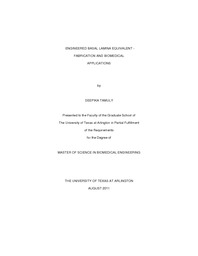
ATTENTION: The works hosted here are being migrated to a new repository that will consolidate resources, improve discoverability, and better show UTA's research impact on the global community. We will update authors as the migration progresses. Please see MavMatrix for more information.
Show simple item record
| dc.contributor.author | Tamuly, Deepika | en_US |
| dc.date.accessioned | 2011-10-11T20:49:18Z | |
| dc.date.available | 2011-10-11T20:49:18Z | |
| dc.date.issued | 2011-10-11 | |
| dc.date.submitted | January 2011 | en_US |
| dc.identifier.other | DISS-11302 | en_US |
| dc.identifier.uri | http://hdl.handle.net/10106/6203 | |
| dc.description.abstract | A novel technique based on the principle of solvent casting is developed to create uniform, ultrathin and stackable films of Collagen I/IV and ECMgel for use as Engineered Basal Lamina Equivalent. The mixture of these two proteins provides key molecular elements (laminin, collagen type IV, entactin and perlecan) in a basal lamina with strong mechanical properties (collagen type I). Rat tail derived collagen solution is mixed with ECMgel, and the solution is cast onto PDMS molds and air dried in a custom built air tunnel. The dried membranes are briefly UV cross-linked, peeled off from the PDMS mold to be used for its various applications. Thickness of the membrane can be controlled by the amount and concentration of the protein mixture (0.5 - 1 µm) and is very uniform for the entire membrane. The basal lamina membrane has been positively stained for both collagen type I and laminin. In 2D applications, six different types of cells have been cultured: human aortic endothelial cells, human glioblastoma multiforme, human fibroblasts, human astrocytes, human smooth muscle cells and E-18 derived rat cortical neurons. All these cell types demonstrated a robust growth on the membrane with a positive staining to specific antibodies corresponding to each cell type. As 2D applications do not entirely resemble the true native environment, the basal lamina membrane has been used for developing 3D applications. In one application a novel technique has been developed to create a 3D stack of cortical neurons resembling the cortical layers in the mammalian brain. E18 derived rat cortical neurons are cultured on 3 separate layers of the basal lamina membrane and then stacked together allowing the axons from one layer to migrate to the adjacent layers forming a complex network of dense axons in 3 dimensions as seen in the mammalian cortex. This 3D model has been used to study the migration of glioblastoma cells in which an additional layer of human glioblastoma multiforme cells is added onto the cortical neuron stack and the cells are allowed to migrate to the lower layers for specific time points. This application has also been developed to create a blood brain barrier model where endothelial cells are cultured on the basal lamina membrane and stacked above the layers of cortical neurons. This technique provides a unique and easy to fabricate 3D cell culture model which brings us closer to the native environment and can be used to study the interactions between different cell types. Using this technique the cells in each individual layer of the stack can also be easily controlled. The second application developed using the basal lamina equivalent is of a gas exchanger. The permeability of the membrane is controlled by using a higher concentration of collagen type I (6 mg/ml) because of which the membrane is impermeable to water but highly permeable to oxygen. The exchange of oxygen is allowed to take place across the membrane with water running on one side and oxygen on the other. The significant change (p < 0.01) in the concentration of dissolved oxygen in the water was measured before and after running the experiment using a dissolved oxygen sensing meter.The membrane being ultrathin brings the distance of exchange of oxygen closer to the native environment. | en_US |
| dc.description.sponsorship | Kim, Young-Tae | en_US |
| dc.language.iso | en | en_US |
| dc.publisher | Biomedical Engineering | en_US |
| dc.title | Engineered Basal Lamina Equivalent - Fabrication And Biomedical Applications | en_US |
| dc.type | M.S. | en_US |
| dc.contributor.committeeChair | Kim, Young-Tae | en_US |
| dc.degree.department | Biomedical Engineering | en_US |
| dc.degree.discipline | Biomedical Engineering | en_US |
| dc.degree.grantor | University of Texas at Arlington | en_US |
| dc.degree.level | masters | en_US |
| dc.degree.name | M.S. | en_US |
Files in this item
- Name:
- Tamuly_uta_2502M_11302.pdf
- Size:
- 2.481Mb
- Format:
- PDF
This item appears in the following Collection(s)
Show simple item record


